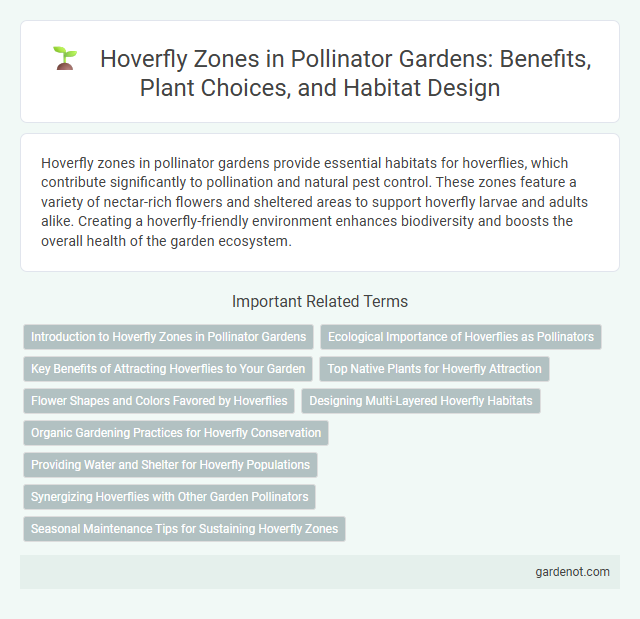Hoverfly zones in pollinator gardens provide essential habitats for hoverflies, which contribute significantly to pollination and natural pest control. These zones feature a variety of nectar-rich flowers and sheltered areas to support hoverfly larvae and adults alike. Creating a hoverfly-friendly environment enhances biodiversity and boosts the overall health of the garden ecosystem.
Introduction to Hoverfly Zones in Pollinator Gardens
Hoverfly zones in pollinator gardens create essential habitats that attract hoverflies by providing diverse flowering plants rich in nectar and pollen throughout the growing season. These zones support hoverfly populations, key pollinators known for their ability to hover in place and their larvae's role in controlling aphid populations. Establishing hoverfly zones enhances biodiversity, improves pollination efficiency, and promotes a balanced ecosystem within the garden.
Ecological Importance of Hoverflies as Pollinators
Hoverflies play a crucial role in pollinator gardens by efficiently transferring pollen between flowers, significantly enhancing plant reproduction and biodiversity. Their larvae contribute to natural pest control by feeding on aphids, reducing the need for chemical pesticides. Supporting hoverfly populations promotes ecological balance and boosts the overall health of garden ecosystems.
Key Benefits of Attracting Hoverflies to Your Garden
Hoverflies play a vital role in pollination by transferring pollen between flowers, enhancing crop yields and biodiversity in your pollinator garden. Their larvae naturally control aphid populations, reducing the need for chemical pesticides and promoting a healthier garden ecosystem. Creating a hoverfly zone attracts these beneficial insects, supporting ecological balance and boosting overall plant health.
Top Native Plants for Hoverfly Attraction
Top native plants for hoverfly attraction in a pollinator garden include yarrow (Achillea millefolium), wild carrot (Daucus carota), and fennel (Foeniculum vulgare). These plants provide abundant nectar and pollen, essential for adult hoverflies, while supporting larval habitats that help control aphid populations. Incorporating a diverse mix of native flowering species ensures continuous bloom periods, optimizing hoverfly presence and enhancing pollination effectiveness.
Flower Shapes and Colors Favored by Hoverflies
Hoverflies are particularly attracted to flat, open-faced flowers such as umbels, daisies, and composites that provide easy access to nectar and pollen. They favor bright colors, especially yellow, white, and purple blooms, which enhance visibility and appeal. Planting a diversity of these flower shapes and colors increases hoverfly visitation, promoting effective pollination within the garden.
Designing Multi-Layered Hoverfly Habitats
Designing multi-layered hoverfly habitats in a pollinator garden involves incorporating diverse plant species that provide nectar, pollen, and larval breeding sites across different vegetation heights. Including flowering plants like wildflowers and herbs in ground, shrub, and canopy layers attracts hoverflies at various life stages and encourages natural pest control. Strategically positioning moist soil patches and decaying organic matter further supports hoverfly larval development and enhances garden biodiversity.
Organic Gardening Practices for Hoverfly Conservation
Creating a Hoverfly zone within a pollinator garden enhances organic gardening practices by reducing chemical pesticide use and promoting biodiversity. Planting native flowering species that bloom throughout the growing season provides essential nectar and pollen resources, supporting hoverfly populations naturally. Incorporating organic mulches and maintaining moist soil conditions also encourages hoverfly larvae habitats, vital for pest control and ecological balance.
Providing Water and Shelter for Hoverfly Populations
Hoverfly zones in pollinator gardens thrive with dedicated water sources such as shallow dishes filled with pebbles and fresh water to prevent drowning and aid hydration. Incorporating dense vegetation, decaying wood, and mulch offers essential shelter and breeding sites for hoverfly larvae, supporting lifecycle sustainability. Strategic placement near nectar-rich flowers maximizes hoverfly attraction and pollination efficiency.
Synergizing Hoverflies with Other Garden Pollinators
Hoverfly zones enhance pollination by attracting these efficient insects alongside bees, butterflies, and beetles, creating a dynamic ecosystem that boosts flower fertilization rates. Hoverflies contribute to controlling aphid populations, which benefits other pollinators by maintaining plant health and ensuring abundant nectar sources. Integrating hoverfly-friendly plants such as alyssum and fennel fosters pollinator diversity and optimizes garden productivity through complementary foraging behaviors.
Seasonal Maintenance Tips for Sustaining Hoverfly Zones
Regularly remove faded flowers to encourage continuous blooms that attract hoverflies throughout the growing season. Avoid chemical pesticides and opt for organic mulching to maintain a healthy habitat supporting hoverfly larvae and adults. Monitor and manage moisture levels by watering during dry periods, ensuring optimal conditions for hoverfly activity and reproduction.
Hoverfly zone Infographic

 gardenot.com
gardenot.com